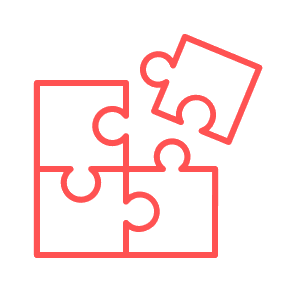Set clear and achievable goals
Goals describe what you want to achieve in the future. Think of a personal goal such as completing your studies in two years or a business goal such as achieving a 22% market share by the end of the year. By setting a goal, you indicate that you truly want something; you are making a commitment to yourself and others to achieve that goal. You must be able to visualize the goal and the path to it, be committed, and then persevere to achieve it. Whether it’s commercial goals, KPI goals, long-term goals, policy goals, or concrete business objectives such as reducing energy consumption or absenteeism. How do you approach this smartly? The first step is to make sure you formulate your goals in a SMART way. In this article, we go into more detail about the different types of goals and give 5 tips on how to achieve your company goals faster.
What are goals and objectives?
Goals represent a dot on the horizon – a destination that you, your organization, department, or team aim to reach, often within a specific timeframe. You describe a goal as an objective. We define objectives as follows:
An objective is a formulation of a goal that you as a person, team, department, or organization want to achieve within a certain timeframe.
Ideally, every objective should be formulated SMART, though this is often not the case. The key characteristic of a good objective is that it always includes a future moment. This allows you to work toward it with focus; otherwise, it remains a vague aspiration. Some examples of objectives include:
- We want to become the biggest supermarket chain in the United States
- Successfully complete a Data Science training course within one year
- Minimize the number of errors in a process to less than 1%
- Reduce the throughput time of a specific process to a maximum of 2 hours
- Reduce the transport costs of a specific route by ten percent
- Achieve the sales objectives (sales targets) in the next quarter
- Reduce the energy consumption of your factory by 30%
- Become a celebrity or influencer
- Find a good business location by 2025
Each person or organization may have different goals. It depends on what you want to excel at, either individually or as an organization, and what the higher or long-term goal is. Having the specific knowledge required to reliably achieve a goal in the foreseeable future is essential.
Types of objectives
 There are different types of objectives. First, we distinguish between personal, team, departmental, or organizational objectives. This refers to the scope of the objective. However, the most commonly used classification for describing different types of objectives is the familiar distinction between operational, tactical, and strategic.
There are different types of objectives. First, we distinguish between personal, team, departmental, or organizational objectives. This refers to the scope of the objective. However, the most commonly used classification for describing different types of objectives is the familiar distinction between operational, tactical, and strategic.
- Operational: these objectives relate to your daily work – for example, consistently answering all emails every day.
- Tactical: these objectives concern how you handle your daily tasks – for instance, answering only high-priority emails each day.
- Strategic: these objectives relate to your company’s overall strategy or operations – for example, deciding to stop answering emails altogether and instead handle all communication via chat, WhatsApp, phone calls, or face-to-face (if possible).
With operational objectives, you generally do more of the same, which carries the risk of falling behind. Tactical objectives involve doing less of the same while optimizing the process to gain more traction. Strategic objectives take an entirely different approach.
It is very important to scale up from operational to tactical, and from tactical to strategic, in a timely manner – otherwise, you risk missing the boat.
Bring consistency to your objectives
 In a single organization, there can sometimes be hundreds of goals. Additionally, employees have personal goals they want to achieve. How can you ensure that all of these align precisely? You do this with a Balanced Scorecard. It brings clear structure to all (types of) objectives, preventing them from conflicting with one another. As a result, you achieve your goals more quickly and with greater agility.
In a single organization, there can sometimes be hundreds of goals. Additionally, employees have personal goals they want to achieve. How can you ensure that all of these align precisely? You do this with a Balanced Scorecard. It brings clear structure to all (types of) objectives, preventing them from conflicting with one another. As a result, you achieve your goals more quickly and with greater agility.
Formulate objectives in line with the strategy
Every organization has formulated goals, but not all of them consistently link these goals to the organizational strategy. Setting goals or making plans without a strategic component is like trying to drive from A to B in half an hour without knowing why you’re going there. Goals should always carry or be given meaning – a higher purpose or the mission of the organization. That’s why it’s essential to ensure your operational or tactical objectives align with your business strategy or the bigger picture.
Targets & Data
 You need to be able to track your progress on your goals – after all, you want to know where you currently stand in relation to the target. This requires data and information to monitor progress, along with fast and reliable feedback on your objectives. This is often done through a dashboard or Business Intelligence tools. Sharing and discussing the information, knowledge, and insights that arise from the dashboard is essential. The goal is to make decisions that eliminate any delays or help you reach your target more quickly.
You need to be able to track your progress on your goals – after all, you want to know where you currently stand in relation to the target. This requires data and information to monitor progress, along with fast and reliable feedback on your objectives. This is often done through a dashboard or Business Intelligence tools. Sharing and discussing the information, knowledge, and insights that arise from the dashboard is essential. The goal is to make decisions that eliminate any delays or help you reach your target more quickly.
Make goals measurable with the goal tree
Suppose your company needs to find a new, suitable business location. Using a so-called goal tree, you can easily and visually break down the main goal into sub-goals. This helps everyone understand what is important to achieve the “highest” goal and how each sub-goal contributes to it. As an example, we provide a goal tree (KPI tree) from a hospital.
Objectives must also be SMART
Objectives that are not formulated in a SMART way will never be achieved. Therefore, always formulate SMART goals. These are specific, measurable, acceptable, realistic, and time-bound.
5 tips to reach your goals faster
- Make “the why” crystal clear to everyone involved. If your employees lose sight of the goal, they can still act in line with the why. Understanding the purpose helps them connect with the goal, leading to stronger engagement and support.
- Always make your goals measurable using SMART goal setting. This allows you to make timely adjustments when unforeseen circumstances arise or priorities shift.
- Ensure that different goals and sub-goals don’t conflict. Avoiding contradictory objectives prevents energy loss and inefficiency.
- Equip your employees with the right resources. Make sure they have what they need to contribute effectively to the goal. Listen to complaints and address concerns seriously.
- Break the journey into smaller, manageable steps. Instead of aiming to achieve everything at once, set small or medium-sized milestones. Reaching these along the way creates momentum and generates positive energy for everyone involved.
Interested in achieving your goals faster?
Passionned Group’s specialists are highly experienced in organizational management and data-driven operations. You can consult our experts for assistance in developing a goal tree, implementing performance management, or applying KPI-based steering. Feel free to contact us for an exploratory conversation or to participate in one of our training programs.
About Passionned Group
 Passionned Group is the specialist in control and performance management, helping you reach your goals faster. Our dedicated professionals support both large and small organizations in becoming more intelligent. Every two years, we organize the competition for the Smartest Organization in the Netherlands.
Passionned Group is the specialist in control and performance management, helping you reach your goals faster. Our dedicated professionals support both large and small organizations in becoming more intelligent. Every two years, we organize the competition for the Smartest Organization in the Netherlands.


